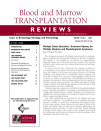Myelodysplastic Syndrome: The Transplanter’s Quandaries
by John R. Wingard, Editor
Although the myelodysplastic syndromes (MDS) are not curable without hematopoietic cell transplant (HCT), advances in non-transplant therapies today offer considerable benefit to our patients. Over the years, prognostic algorithms have been developed and validated and these are useful guides to allow us to more accurately predict the likely trajectory of disease progression in a group of syndromes that have a notorious heterogeneity.
For lower risk MDS, advances in supportive care include optimization of when and how to administer hematopoietic growth factors and the growing recognition of the importance of iron (enough but not too much) and ways to deal with it. The introduction of demethylating agents has provided substantial benefit as well, controlling disease manifestations and delaying progression to leukemia and extending survival in some patients. Even older drugs such as anti-thymocyte globulin and newer drugs such as lenalidomide have their roles for certain subsets of patients. Other classes of new drugs are in the pipeline. Having more choices is indeed gratifying for a group of patients in whom just a few short years ago there were few good choices. With new choices come new dilemmas: for whom what choice is best for a given patient.
The quandaries of MDS for the transplant clinician are several: who should be offered HCT, when should transplant be done in those who need HCT, and how best to do the transplant. These are the topics addressed in this issue. A symposium presented at the 2008 BMT Tandem Meetings in San Diego, CA addressed a number of these thorny issues. While the answers are not yet in, there is a ferment of clinical research underway to provide guidance that we can apply to individual patients. Needed clinical trials are underway to developing safer and more effective HCT strategies. Hopefully more are to come.
Download a PDF version of the full issue.

